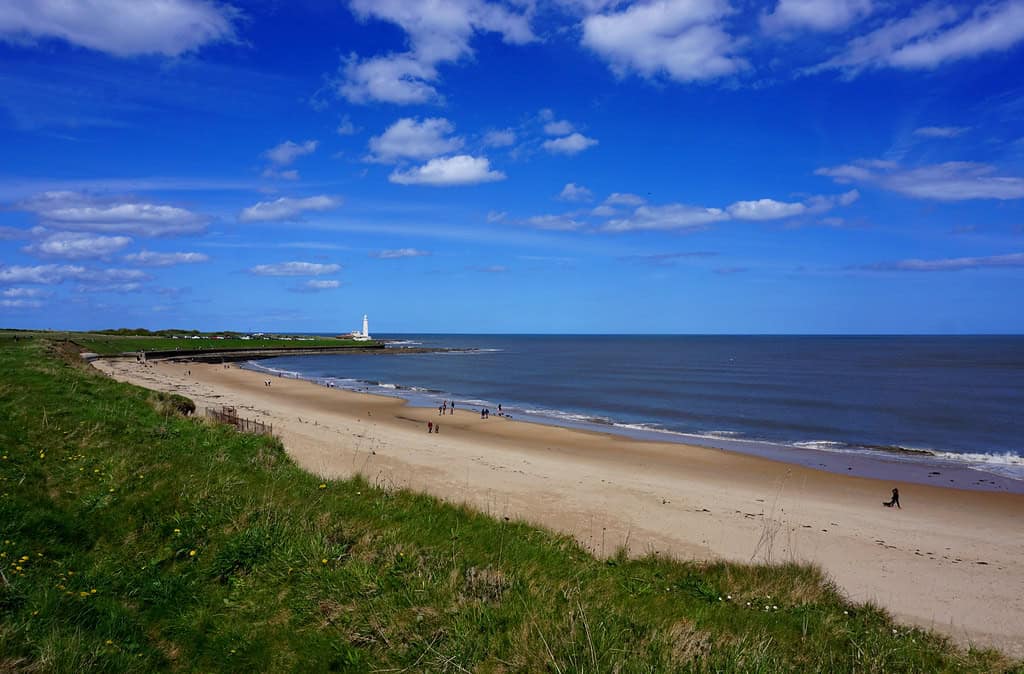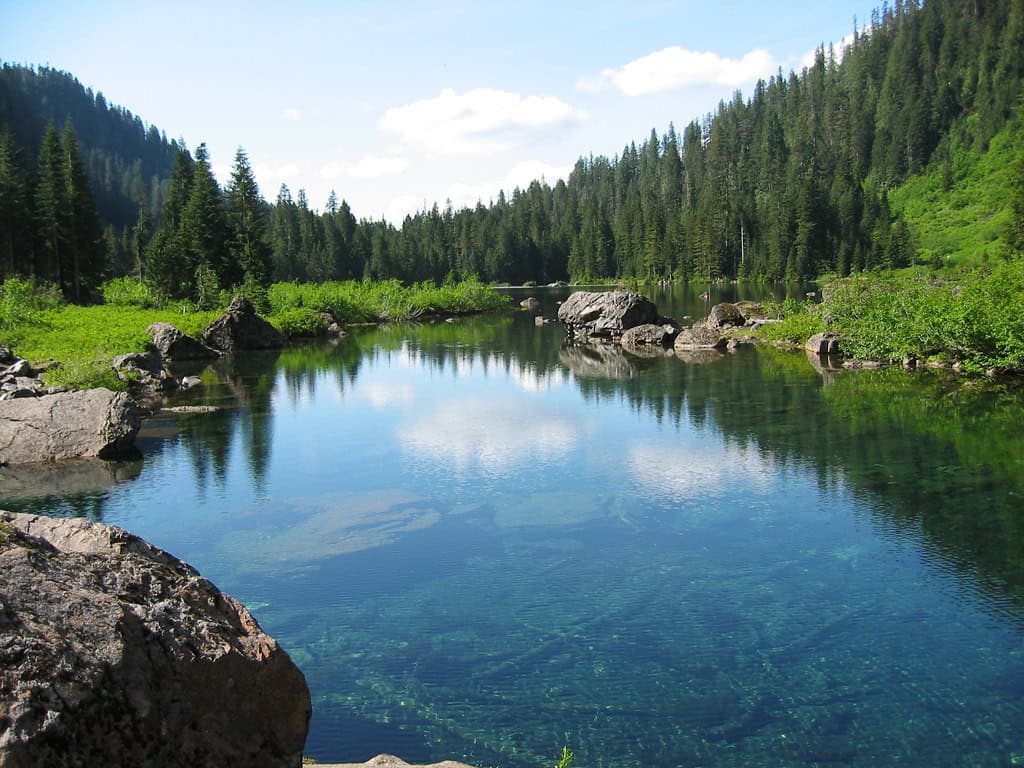If you are learning everything you can about Tiny Home Communities, how they work, pros and cons or if one might be for you, you are in luck.
This article will be your guide to helping you answer the question, What is a Tiny Home Community.
Because while they look great on Facebook or YouTube, there is a lot to know before committing to downsizing and moving in.
For many people, the dream looks like this:
Less house. Less stress. More freedom.
Moving into a tiny home community is not just a housing decision. It is a lifestyle decision, a financial decision, and a long-term comfort decision.
If you are downsizing, nearing retirement, or just tired of traditional housing, this guide will help you figure out if tiny home community living fits your life, not just your Pinterest board.
There are so many ways a tiny home community can be set up. It is not cookie-cutter or one size fits all!
- Tiny home communities aren’t all the same: each one has its own setup, rules, and home types.
- Lot rent and monthly fees add up: always ask what’s included, what’s metered, and how often rates change.
- Leases and HOA rules decide your stability: clear documents protect you more than vague promises.
- Community culture matters: neighbors, noise level, and management shape your daily life.
- Rules can limit your options: age limits, rental policies, and home standards affect who can live there.
- Moving a tiny home is costly: relocation takes planning and money, so choose a stable park.
- The best community depends on your lifestyle: decide if you want quiet, social, flexible, or predictable living.
Definitions to Know
Tiny House: A tiny house is a small, efficient home usually between 100 and 400 square feet. It can be built on wheels or a foundation and is designed to maximize space and simplify living.
Tiny Home: (This term is not very well defined by anyone, so here is my definition.) A tiny home is any small living space under 1,000 square feet. The focus is simple living in a smaller footprint.This broad category can include tiny houses, RVs, park models, small cottages, yurts, cabins, and shipping container homes. Most tiny homes are between 300-750 sf.
Tiny House Movement: The tiny house movement is a shift toward living in smaller, more efficient homes to save money, reduce clutter, and focus on a simpler lifestyle. People in this movement choose smaller dwellings as a way to cut housing costs, lower their environmental impact, and live with more intention instead of more stuff.
Disclosure: This post may contain affiliate links, meaning I can earn commissions. If you decide to purchase through my links, it is at no cost to you.
What Is a Tiny Home Community?
A tiny home community is a neighborhood built around tiny homes or smaller homes and a simpler way of living.
Homes might be tiny houses on wheels, park models, small cottages on foundations, or even RVs, depending on how the community is set up.
I have also seen some be containers homes, have Yurts, or allow Skoolie parking.
Many tiny home communities focus on affordability, shared resources, and a sense of neighborly connection.
You can find them in all kinds of settings:
- Rural mountain retreats
- Lakeside resorts
- Age-restricted retirement villages
- Converted RV parks
- Purpose-built tiny home villages
Some communities are set up for full-time living.
Others are more like vacation spots where you “try on tiny” for a season or a few weekends a year.
How Zoning Affects What a Tiny Home Community Can Allow
Zoning is one of the biggest factors that decides what types of homes a community can accept.
Even if a community wants to allow tiny houses, THOWs, RVs, or park models, local zoning rules may limit what’s possible.
Why Zoning Matters
- It decides whether people can live there full time or only part time.
- It determines whether RVs or park models are allowed as long-term homes.
- It affects how utilities must be installed and inspected.
- It can limit how many homes can be placed on the property.
- It influences whether tiny homes must be on foundations or can stay on wheels.
RV Zoning
- Allows RVs, fifth wheels, and some THOWs.
- Often limits stays to 30, 60, or 180 days.
- Not always approved for full-time, year-round living.
- Homes stay on wheels and plug into pedestal hookups.
Tiny Home Zoning
- Allows small homes built to specific building codes or manufactured housing codes.
- May require homes to be placed on a permanent foundation.
- More likely to allow full-time living.
- Utilities are installed like a traditional house.
Related Articles 📚
Park Models and Zoning
Park models are legally classified as RVs (ANSI 119.5), so zoning makes a huge difference:
- In RV zoning, they’re allowed but may have stay limits.
- In tiny home or residential zoning, they may require extra steps like permits or foundation options.
- In mixed-use zoning, they’re often allowed long-term if utilities meet code.
Short-Term vs. Long-Term Living
Zoning often decides:
- How long you can stay
- Whether you’re considered a “permanent” resident
- If the community can legally offer full-time housing
- Whether your address can be used for mail, driver’s licenses, or voting
This is why some communities advertise “full-time friendly” while others clearly state they’re seasonal or limited-stay only.
Why This Matters When Choosing a Community
If a property isn’t zoned for long-term residential use:
- You may not be allowed to live there year-round.
- The community may face pressure from the city to change or tighten rules.
- Full-time living may only be allowed until the city enforces updates.
- You may be asked to move your tiny home unexpectedly.
What to Ask Up Front
- What is the property zoned for? (RV park, residential, mixed-use, etc.)
- Does zoning allow full-time, year-round living?
- Are THOWs allowed or do homes need a foundation?
- Are park models allowed long-term or are there stay limits?
- Has the community had zoning issues in the past?
- Are there any zoning changes coming?
Types of Tiny Home Communities
Not every tiny home community works the same way. In general, there are three ways a tiny home community could be set up:
- Rent/Lease Land, Own Home
- Own Land, Own Home
- Rent/Lease Home and Land

The structure you pick affects:
- Your freedom
- Your monthly budget
- The culture of the community
- Even how easy it is to move if things change
1. Lease-the-land & Own the Home Communities
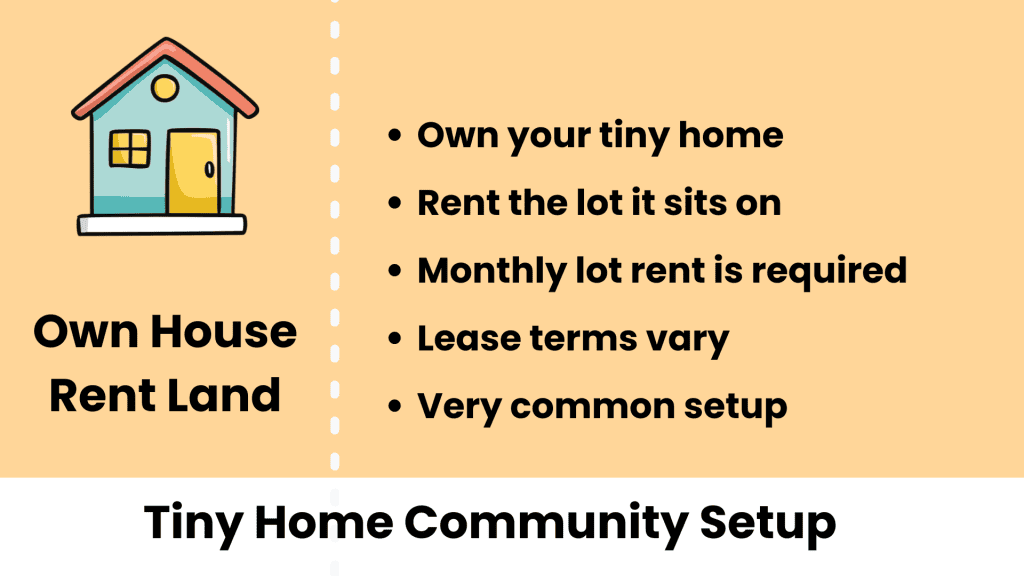
What’s Usually Included
- Water, sewer, and trash service
- Basic lawn care
- Sometimes Wi-Fi, road maintenance, or security lighting
- Some services/utilities may be metered.
What does “Metered” Mean
A metered utility tracks your individual usage instead of charging a flat fee. Electric is often metered. Some communities also meter water or propane.
You get a separate bill based on how much you use, similar to a traditional home. This can be good if you’re a light user but can cost more if your home needs extra heating or cooling.
Common Amenities
- Clubhouse or community center
- Lakes, walking paths, or green space
- Dog park
- Fire pits or outdoor gathering areas
- Community gardens or shared entertaining spaces
These shared spaces often make daily life feel more social and connected.
Why People Choose This Model
- Lower upfront cost since you’re not buying land
- Good option if you want flexibility or plan to “try” tiny living
- Helps you move into a community without taking on a land loan or land prep
Tradeoffs to Consider
- Lot rent can increase over time
- You have less control if ownership or management changes
- Rules or community goals may shift
- You may have to move your home if leases end or the park changes direction
- Moving a tiny home or park model can be costly and requires professional transport
What to Ask When Leasing Land In a TIny Home Community
- Future development plans or known changes in ownership
- How often lot rent has increased in the past three to five years
- Available lease lengths and whether long-term leases are offered
- Which utilities are included and which are metered
- Whether there are added fees for amenities or storage
- What are the property rules and regulations
- How are rules regarding the property enforced
2. Own-the-land communities & Own the Home

What HOA (Homeowners Association) Dues Usually Cover
- Road maintenance and common-area upkeep
- Landscaping for shared spaces
- Water, sewer, or trash service (varies by community)
- Access to amenities like a clubhouse, pool, or trails
- Community insurance for shared buildings or structures
What is an HOA?
An HOA manages the community’s rules, appearance, and shared spaces.You pay dues to support maintenance and improvements.In return, the community stays clean, safe, and consistent.
Home Types Typically Allowed
- Tiny homes on permanent foundations
- Park model RVs placed permanently
- Modular or small cottage-style homes
- Sometimes THOWs, depending on zoning and local rules
Foundation homes are common because they meet local building codes and are easier to finance or insure.
Common Amenities
- Clubhouse or gathering space
- Fitness room or pool
- Dog park
- Trails and green space
- Community garden
- Gated entrances or security lighting
These vary widely, but most land-owned communities aim for a neighborhood feel.
Why People Choose This Model
- Long-term stability and more control
- Your home and land may appreciate together over time
- No lot rent increases
- Easier to finance, especially if the home is built on a foundation
- Strong appeal for retirees who want predictability
Tradeoffs to Consider
- Higher upfront cost since you’re buying land
- HOA dues can rise each year
- You must follow the community’s building standards and design rules
- You may need permits or inspections for decks, carports, and additions
- Selling your home requires finding a buyer who fits community rules
What to Ask Up Front
- The resale history in the community (fast sales vs slow)
- What the HOA dues cover and how often they increase
- Whether the home must be on a foundation or if THOWs are allowed
- Any restrictions on exterior changes, fencing, or landscaping
- Rules for renting your home long-term or short-term
- Whether there is a reserve fund for future repairs or upgrades
Related Articles 📚
3. Rent the Home & Land: Tiny home and park model rentals
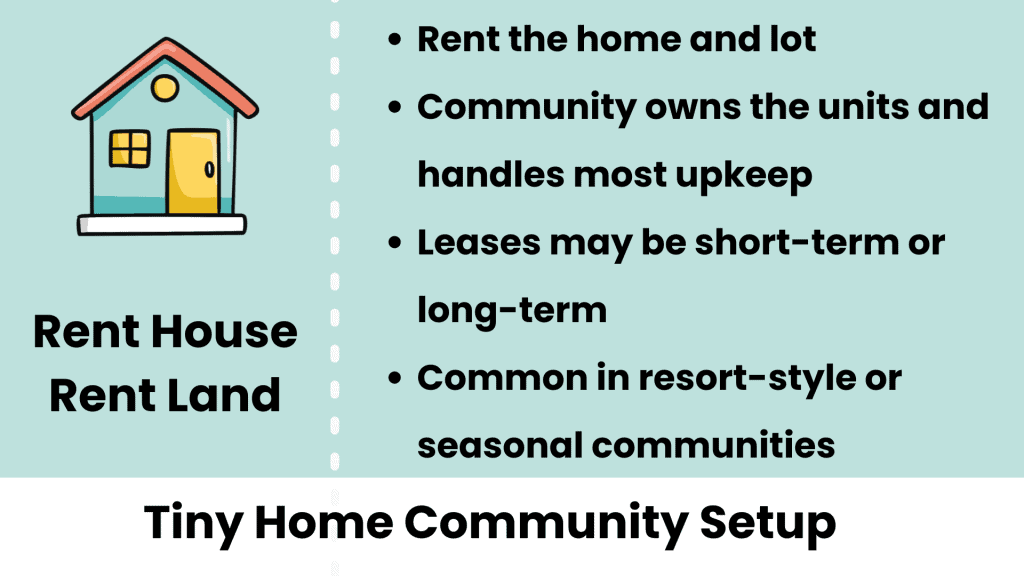
What’s Usually Included
- The fully set-up tiny home or park model
- Water, sewer, and trash service
- Lawn care
- Access to community amenities
- Sometimes electric, Wi-Fi, or streaming packages
Always check which utilities are covered and which are billed separately.
What You’re Actually Renting
- You aren’t buying a tiny home.
- You aren’t buying land.
- You’re renting a ready-to-live-in unit, much like an apartment or vacation rental.
- Some communities allow month-to-month stays, while others require a full lease.
Common Amenities
- Clubhouse or shared lounge
- Pool or hot tub
- Walking trails and green space
- Laundry facilities
- Dog park
- Outdoor cooking or fire pit areas
These amenities often attract people who want low maintenance and built-in community.
Why People Choose This Model
- No large down payment or land purchase
- Perfect for “trying out” tiny living before committing
- Great for seasonal residents, traveling workers, or retirees exploring a new area
- No transport, setup, or utility hookup costs
- Maintenance is usually handled by the community
Tradeoffs to Consider
- Monthly rent may be higher than owning your own home
- You have no equity in the home
- You’re limited to the layout and design the owner provides
- Long-term rent increases can affect affordability
- Availability can be limited in popular communities
What to Ask Up Front
- If the community allows long-term stays or requires seasonal move-outs
- Lease length and renewal options
- What utilities are included vs separately billed
- Pet rules and guest rules
- How maintenance requests are handled
- Whether you can personalize the home (paint, shelves, small upgrades)
Understanding the Different Community Setups
Tiny home communities come in a few different formats, and each one offers a different kind of experience.
Knowing these setups helps you figure out which style fits how you want to live.
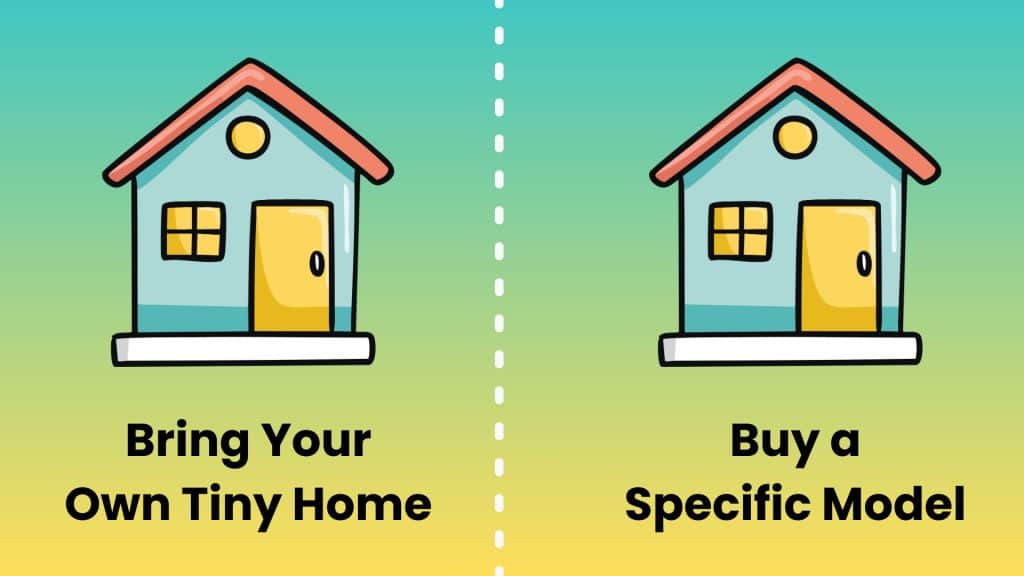
“Bring your own” communities vs. Buy a specific Model
How “Bring Your Own” Works
- You bring your own home into the community.
- Allowed units often include:
- Tiny house on wheels (THOW)
- Park model RV
- Traditional RV or fifth wheel
- Communities may have guidelines for:
- Size limits
- Age limits on RVs or older tiny homes
- Required certifications like RVIA, NOAH, or ANSI standards
- This setup offers more freedom to choose your builder, design, and layout.
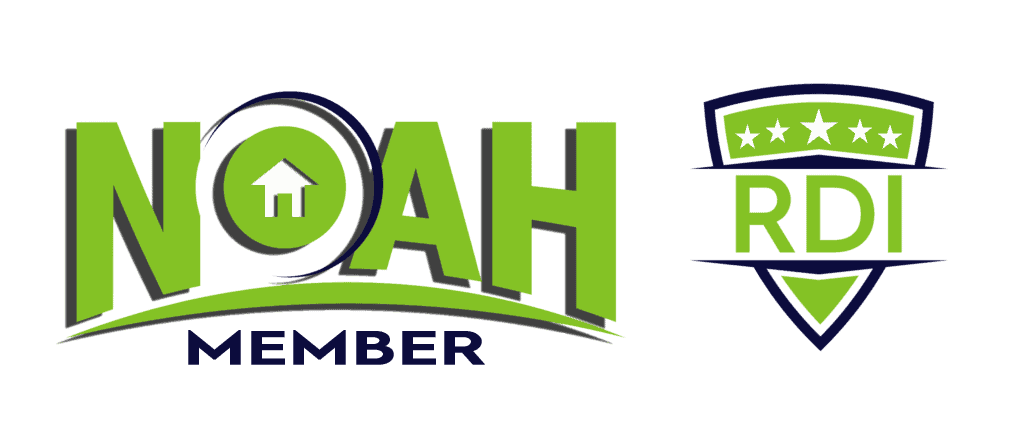
Why Some People Prefer “Bring Your Own”
- Flexibility in choosing your home style and floor plan
- Ability to shop around for pricing and quality
- You can move your home to another community later if needed
Tradeoffs to Consider
- Moving, transporting, and setting up your home adds cost
- The community may require inspections before move-in
- You’re responsible for ongoing maintenance and exterior standards
How “Buy a Specific Model” Works
- The community partners with one or more builders/manufacturers.
- You must purchase an approved model to live there.
- Homes are often pre-designed to match the community’s look and standards.
Why Communities Do This
- Ensures consistency in appearance and quality
- Makes setup easier because homes are already designed for the park
- Helps maintain property values and a unified neighborhood feel
Why Some People Prefer This Option
- Streamlined process with fewer decisions
- The home is already approved for the community
- Easier setup, installation, and warranty work
Tradeoffs to Consider
- Less freedom to choose your own builder or layout
- Pricing may be higher than shopping independently
- Limited to the models the community offers
Permanent foundation tiny home neighborhoods Vs. Tiny House on Wheels
How Permanent Foundation Communities Work
- Homes are built on a fixed foundation, similar to small cottages or park model setups.
- Units must meet local building codes and zoning rules.
- Utilities are connected like a traditional house with standard hookups.
- These communities often feel like small neighborhoods rather than RV parks.
Why People Choose Foundation Homes
- More stability and a “neighborhood” feel
- Easier to finance through traditional lenders
- More insurance options and better long-term security
- Home and land may appreciate together in some areas
- Great for full-time living and long-term planning
Tradeoffs to Consider
- Higher upfront cost
- Less flexibility — the home cannot be moved later
- More rules about exterior design and landscaping
- Some communities only allow specific builders or models
How Tiny House on Wheels (THOW) Communities Work
- Homes are built on trailers and designed to be movable.
- THOW communities operate more like tiny house villages or upgraded RV parks.
- Utilities may be connected at pedestal hookups or through semi-permanent setups.
- Rules vary depending on local zoning and whether the community allows long-term stays.
Why People Choose THOW Living
- Flexibility to move your home if needed
- Typically lower cost than foundation builds
- Easier entry into tiny living
- Great for people who travel seasonally or want options
Tradeoffs to Consider
- Financing options are limited
- Insurance can be more complex and may follow RV-style policies
- Homes may depreciate over time like an RV
- Some areas limit how long you can live in a mobile unit year-round
- More maintenance due to mobility and exposure
Which One Fits You?
- Choose a foundation home if you want stability, easier financing, and a long-term place to settle.
- Choose a THOW if you want flexibility, lower upfront costs, or the ability to relocate later.
Related Articles 📚
Short-term Vs Seasonal vs year-round Tiny Home Communities
Short-Term Tiny Home Communities
- Designed for nightly, weekly, or monthly stays.
- Often operate like resorts, campgrounds, or vacation villages.
- Homes may be community-owned rentals or visitor-owned THOWs and RVs.
- You’ll see more turnover, more visitors, and a more “vacation” atmosphere.
Why People Choose This
- Great for trying out tiny living before you commit.
- Perfect for travel nurses, digital nomads, or snowbirds.
- Easy, no long-term commitment.
Tradeoffs
- Less community stability
- Higher daily or monthly cost
- Not ideal if you want a quiet, long-term home
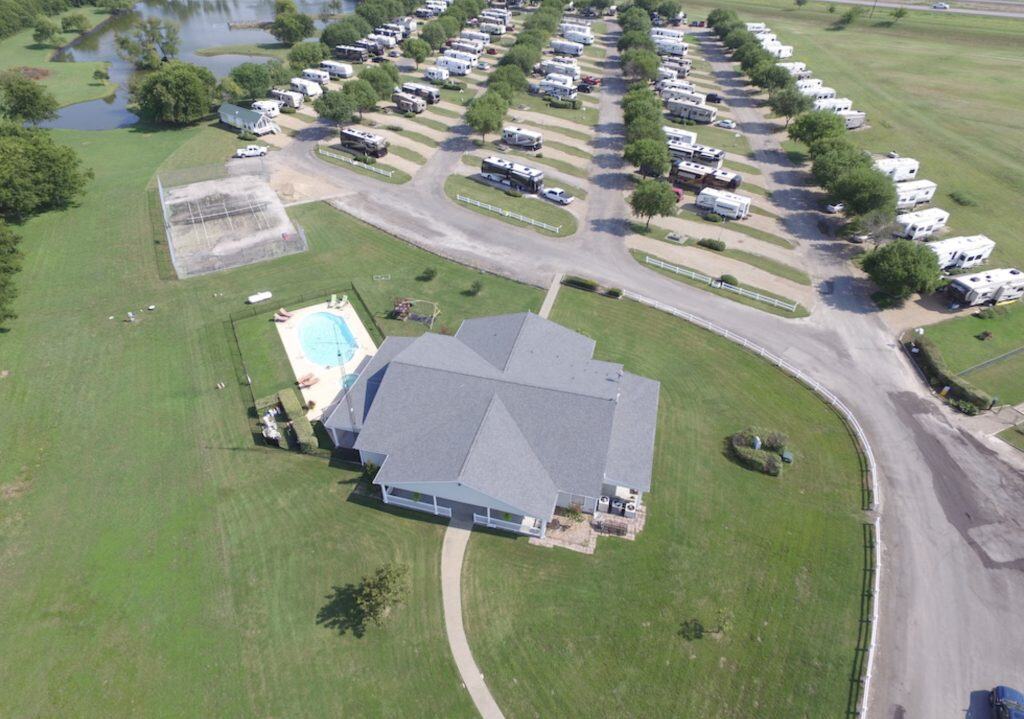
Seasonal Tiny Home Communities
- Open part of the year and closed during off-season months.
- Common in colder climates where THOWs and park models need winterizing.
- Residents often return to the same spot each year, creating a familiar crowd.
Why People Choose This
- Great for snowbirds or part-time tiny living
- Lower yearly cost
- Good option if you divide your time between different states
Tradeoffs
- Not allowed to stay full time
- You must move out or store your home during off-season
- Limited services in colder months
Year-Round Tiny Home Communities
- Open 12 months a year for full-time residents.
- Feels more like a neighborhood than a campground.
- Better suited for retirees, remote workers, and long-term tiny homeowners.
Why People Choose This
- Stable living arrangement
- Predictable community culture
- Utilities and infrastructure built for full-time use
- Good option for long-term planning and downsizing
Tradeoffs
- Higher demand means higher lot rent in popular areas
- More rules and structure than seasonal or short-term parks
Which One Fits You?
- Short-term: You’re testing tiny living or traveling for work.
- Seasonal: You split time between locations or avoid winter in tiny spaces.
- Year-round: You want a stable, everyday home in a tiny community.
Age-Restricted vs. All-Ages Tiny Home Communities
Tiny home communities are becoming especially popular with 40% of tiny homeowners are above 50 years of age who want to downsize, stay active, and keep housing costs under control.
How Age-Restricted (55+) Communities Work
- At least one person in the household must be 55 or older.
- These communities follow the federal HOPA rule.
- Most do not allow children to live there full time.
- The vibe is usually quiet, calm, and consistent.
- Homes may include features that support aging in place, like single-level layouts or wider doorways.
Why People Choose 55+ Communities
- Predictable noise level and routine
- Neighbors in a similar stage of life
- Social events geared toward active adults
- Often safer, more walkable environments
- Many people find it easier to build friendships
Tradeoffs
- Younger partners may need to be approved
- Grandkids can visit but may not be able to stay long
- Rules can be stricter to protect the age requirement
- Not ideal if you want a mixed-age environment
Can Someone Under 55 Live in a 55+ Community?
- Yes, in most cases one partner can be under 55.
- Children usually cannot live there full time.
- Each community handles this differently, so always ask for the written policy.
How All-Ages Tiny Home Communities Work
- Open to anyone regardless of age.
- You may see families, young couples, retirees, travelers, and seasonal residents.
- The culture varies more because the population is mixed.
- These communities can feel lively and social or relaxed and low key, depending on who lives there.
Why People Choose All-Ages Communities
- More flexible if you have kids, grandkids, or younger household members
- A wider mix of neighbors and life stages
- Often more relaxed rules
- Good for people who enjoy a busy or diverse environment
Tradeoffs
- More noise and activity
- Less predictable culture
- More turnover in some communities
- Fewer aging-in-place features or senior-focused amenities
Which One Fits You?
Choose an all-ages community if you prefer variety, flexibility, and a mixed neighborhood feel.
Choose a 55+ community if you want predictability, quiet, and neighbors in a similar season of life.
How much are Lot Rents in a Tiny Home Community and What is Covered
One of the biggest myths about tiny living is that it’s automatically cheap.
Tiny homes can save money, but living in a tiny home community adds its own layer of costs.
Some of the costs in a tiny home community are predictable, and some catch people off guard.
In many tiny home and park model communities, lot rents now range from around $300 to $1,200 per month, depending on the state, the location, and how many amenities the community offers.
If the community includes things like a clubhouse, trails, a pool, or lake access, the monthly fee is usually on the higher end.
Common Monthly Expenses in a Tiny Home Community

Lot rent or HOA fees
Your biggest monthly cost. This covers the right to live on the property and access shared spaces.
Utilities
Most communities handle utilities one of two ways:
- Included in the lot rent
- Metered, meaning you pay for exactly what you use
Common utilities include: water, sewer, electric, propane, internet, and trash.
Propane or fuel
Many THOWs and park models use propane for heat, cooking, and hot water.
Storage fees
If you have tools, outdoor gear, kayaks, or an extra vehicle, some communities charge for storage space.
Pet fees or amenity fees
Dog parks, community gardens, fitness rooms, and clubhouses sometimes come with a small monthly add-on.
One-Time or Irregular Costs in a Tiny Home Community
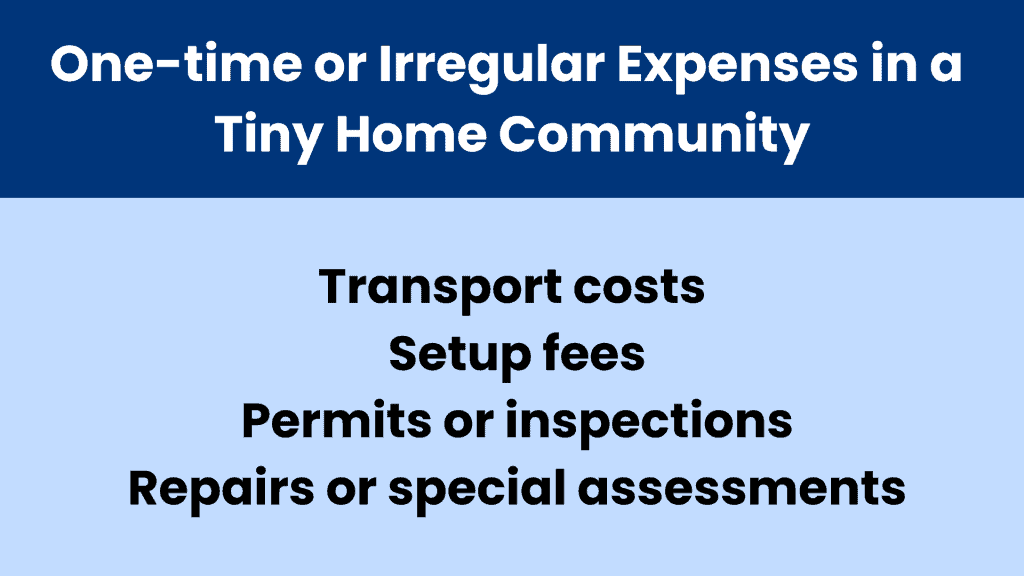
Transporting your tiny home or park model
Moving a tiny home is not like moving a trailer.
The cost to move and transport a tiny home can run anywhere from a few hundred dollars to several thousand depending on distance, size, and difficulty.
Quick Reality Check: Moving a Tiny Home Isn’t Easy
Tiny homes and park models need professional transport. Even a local move can cost hundreds or thousands of dollars.
Some homes need new tires, axles, or structural checks before travel. It’s doable, but it’s not a quick or cheap process.
Setup fees
Most homes need:
- Pads or blocks
- Tie-downs
- Skirting
- Steps or a small deck
- Utility hookups
These costs add up quickly.
Permits or inspections
Some cities require permits for utility hookups, decks, porches, or long-term placement.
Repairs or special assessments
If a community has private roads, wells, septic systems, or shared buildings, repairs may be billed back to residents.
A Tiny Home Doesn’t Remove All Housing Costs
Downsizing reduces square footage, clutter, and daily upkeep. It does not erase the real-world costs of housing.
You may save in some areas:
- Smaller electric bills
- Less furniture
- Lower insurance costs in some cases
- No mortgage if you pay cash
But you’ll still have ongoing expenses related to land use, utilities, maintenance, and community living.
The Key Is Understanding the Full Picture
Before you move, look at:
- Monthly costs
- Annual increases
- Setup costs
- Storage or amenity fees
- Long-term financial commitment
- What’s included vs. metered
- The community’s rent history and stability
Once you see the whole picture, you can choose a tiny home community that feels comfortable, sustainable, and right for your budget long-term.
Ownership and Lease Terms in a Tiny Home Community
Ownership and Lease Terms
Lease terms tell you how much control you really have in a tiny home community.
The length and clarity of your lease can shape everything from your monthly budget to your long-term security.
Key Questions To Ask
- Is the lease month-to-month, yearly, or long-term?
- Are there limits or caps on future rent increases?
- What happens if the owner sells the park or management changes?
- Can the lease be canceled without cause?
- Does the community offer renewal guarantees?
- Are rules the same for all residents, or does management make case-by-case decisions?
Why Lease Terms Matter
- Short or vague leases can create uncertainty and stress.
- If the community is sold or “repositioned,” residents may get new rules or higher rent.
- Some owners shift toward luxury models or vacation rentals, which can change the culture and cost of the community.
- In the worst case, you may need to move your tiny home with little notice.
If You Own the Land Instead
Even when you own your lot, the rules still matter. Read the HOA documents closely because they control:
- Exterior changes
- Landscaping
- Decks, sheds, and additions
- Whether you can rent your home
- Resale expectations and approvals
These rules can affect your freedom, your costs, and the future value of your home.
Rules and Restrictions: The “Fine Print” That Shapes Your Daily Life
The rules of a community matter more than the floor plan of your tiny house.
Some rules protect the neighbors and keep things running smoothly. Others may feel restrictive.
The key is knowing which ones you can live with and which ones are deal breakers.

Common rule areas:
- Guests – How many nights can guests stay? Are there limits on long-term visitors or grandkids in a 55+ community?
- Pets – Breed restrictions, size limits, pet deposit, number of pets allowed.
- Parking – Limits on extra vehicles, RVs, boats, or trailers.
- Noise – Quiet hours, rules about music, generators, yard tools.
- Exterior changes – Rules for decks, porches, skirting, paint colors, sheds, ramps, carports.
- Home age and appearance – Some communities limit older RVs or tiny homes that show wear.
- Rentals – Whether you can rent your unit long-term or short-term.
Long-term vs short-term rentals in the community
This one can quietly change the entire feel of a neighborhood.
- Long-term rentals often bring stability. People stay a while, learn each other’s names, and care about the community.
- Short-term rentals bring more turnover. There are more new faces, more visitors who may not fully understand the rules, and sometimes more noise.
Neither option is automatically bad, but you should know what you are stepping into.
A community that looked calm on a Tuesday afternoon might feel like a resort on a holiday weekend.
Ask directly:
- Are short-term rentals allowed?
- How common are they?
- Are there caps or limits on how many homes can be used this way?
Amenities and Lifestyle Fit
Tiny home communities come with very different amenity packages. The more they offer, the more you usually pay in lot rent or HOA fees.
You might see:
- Clubhouses or community centers
- Shared kitchens or gathering spaces
- Fitness rooms or yoga areas
- Laundry facilities
- Dog parks and walking trails
- Community gardens
- Lakes, pools, or hot tubs
- Fire pits and outdoor cooking areas
The question is not “How many amenities are there?” but “Will I actually use these?”
A social person might love a community that hosts potlucks, game nights, and holiday events.
Someone more private might prefer a quieter place with simple walking paths and a small clubhouse.
Tiny Home Community amenities should match your lifestyle, not just look pretty on the brochure.
Design, Build, and Home Requirements in a Tiny Home Community
Not every tiny home can be placed in every tiny home community. Some communities require:
- RVIA or NOAH-certified units
- ANSI 119.5 park model RVs
- HUD-coded homes
- Homes built on permanent foundations
The type of structure affects:
- Financing – Tiny homes on foundations often have more financing options than THOWs.
- Insurance – Your home might be insured like an RV, a mobile home, or a site-built house, depending on how it is classified.
- Setup and mobility – A THOW gives flexibility to move later. A foundation home gives more stability but less mobility.
Foundations often support traditional utility hookups and put less stress on the structure over time.
A home that travels needs to be built and maintained for movement.
Before you fall in love with a builder or a specific tiny house design, make sure it meets the community’s standards.
Culture and Community Vibe
You can have the perfect tiny house in the wrong community and still feel miserable.
Culture shows up in small ways:
- Do people wave when they walk by?
- Are common spaces clean and welcoming?
- Is the bulletin board full of events, or is it empty?
- Do residents grumble about management or speak well of them?
- Are there a lot of “For Sale” signs or constant move-ins and move-outs?
Communities with strong cultures usually have:
- Clear rules that are actually enforced
- Owners or managers who communicate well
- Residents who feel heard and respected
- A mix of people who stay put and invest in the place
If you are retiring or planning to live in your tiny home long-term, this might matter even more than amenities or floor plans.
Senior tiny home communities in particular often blend privacy with built-in social connection, and that balance is worth paying attention to.
When you visit, give yourself time to just sit and watch.
Listen to what people say when they think no one is “touring” the park.
How To Find a Tiny Home Community
The good news is that tiny home communities are easier to discover now than they were a few years ago.
I have worked on a series showcasing as many tiny home communities as I can find. Here is the playlist.
Here are some other ideas you can start with:
- Online directories and tiny home community lists
- The big guide of tiny home communities across the U.S. on this website, which is updated as new communities appear
- Facebook groups for tiny home living and tiny home communities
- Tiny Home tours and walkthroughs on YouTube
- Local zoning or planning departments
- RV parks that now allow long-term tiny homes or park models
Use these tools to build a shortlist. Then, whenever possible, go visit in person.
Virtual tours can be helpful, but they cannot tell you what it smells like after a hard rain or how loud it gets on a Saturday night.
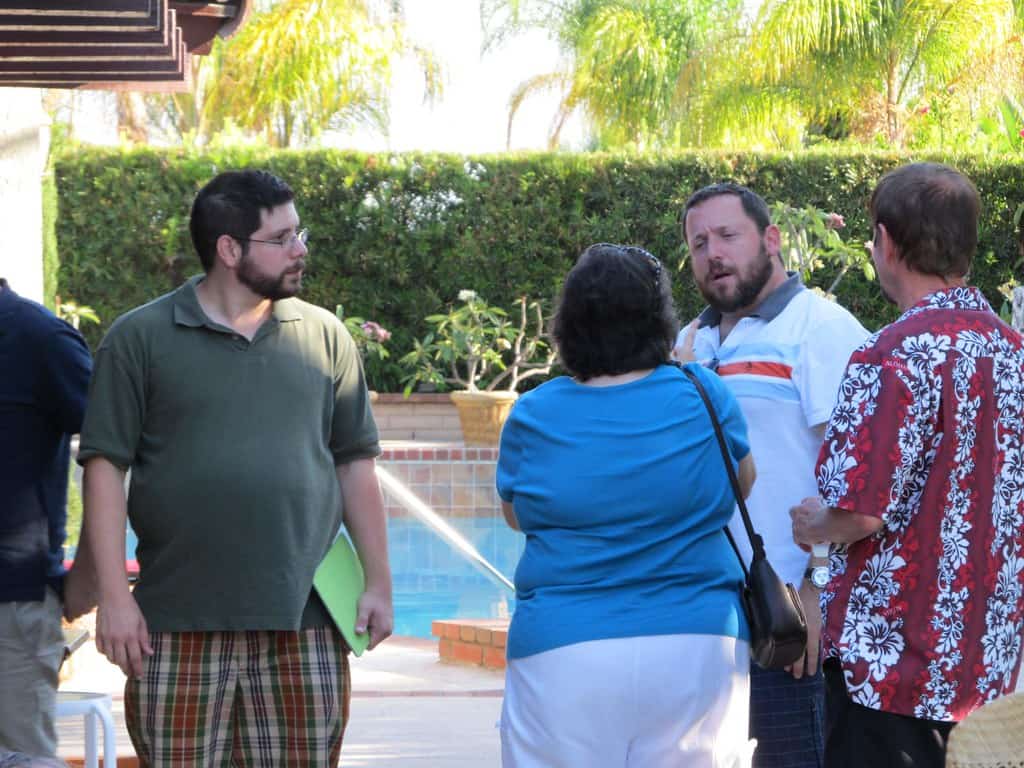
🚩🚩 Red Flags in a Tiny Home Community 🚩🚩
As you compare communities, keep an eye out for warning signs like:
- No written rules or lease, just “we’ll work it out”
- Short-term leases with no clear renewal plan
- Sudden or frequent lot rent hikes
- Unfinished infrastructure, like weak roads or unreliable utilities
- Poor communication from management
- A community currently listed for sale, or constant changes in ownership
- A very high number of short-term rentals in what is sold as a “quiet” community
- Marketing that says “tiny home friendly” but offers only RV hookups and short-stay options
Any one of these is not always a deal breaker on its own, but together they tell you how much risk you are taking on.
Who Tiny Home Communities Are Best For
Tiny home communities are about more than tiny houses.
They are about how you want to live day to day.
Could be a great fit if you:
- Like having neighbors nearby and some built-in connection
- Want to lower housing costs without feeling isolated
- Want low-maintenance living in a smaller space
- Prefer to trade “more house” for “more experiences”
It may not be a fit if you:
- Need maximum privacy and space
- Dislike rules or shared standards
- Have a lot of large vehicles, tools, or outdoor toys and do not want to pay extra for storage
- Want a guaranteed long-term return on your home like a traditional house
Final Thoughts
I hope this article helped you understand what is a tiny home community.
Moving into a tiny home community can be a smart move, especially if you are downsizing, retiring, or ready to trade square footage for freedom.
If you are serious about this step, your next move is to work through a full list of questions before you sign anything.
I put together a separate tiny home community checklist with 50+ questions to ask owners and managers. Use it as your conversation guide so you can spot red flags early and find a community that truly fits your next chapter.
When you choose the right tiny home community, you are not just picking a place to park your home. You are choosing the kind of life you want to wake up to every day.
Frequently Asked Questions
Can you live in a tiny home community full time?
Yes, many tiny home communities allow full-time living. Others are seasonal or set up for short-term stays only.
How is a tiny home community different from an RV park?
Some Tiny home communities are designed for long-term living. RV parks focus more on short stays and may not allow year-round residency or tiny houses.
Are tiny home communities legal everywhere?
No. Zoning laws differ widely by state and city. Some areas support tiny home communities, while others limit long-term tiny house living. Always check local zoning before moving.
Image Source: Canva, Pexels, Pixabay, Open Verse, Unsplash


